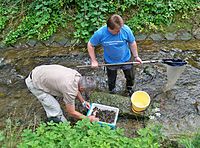
Photo from wikipedia
Abstract An in situ controlled millisecond delay blasting (MDB) experiment was conducted to study the liquefaction behaviour of a sandy field and the liquefaction-induced deformation and damage to a shallowly… Click to show full abstract
Abstract An in situ controlled millisecond delay blasting (MDB) experiment was conducted to study the liquefaction behaviour of a sandy field and the liquefaction-induced deformation and damage to a shallowly buried reinforced concrete structure and an embankment. The pore pressure within the foundation soil, the acceleration and strain responses of the concrete structure and the deformation of the embankment were monitored during a series of blasts. Liquefaction and even sand boils were successfully produced by the explosive loading. Considerable (uneven) settlement and tilt were observed in the concrete structure, and unrecoverable strains were detected by several strain gauges. Uneven settlement also caused some visible cracks near the crest of the embankment, which, based on comparative studies, can be largely alleviated by using geogrids and geotextiles within the foundation soils. The field experiment reported in this study demonstrates that the aforementioned MDB technique and the developed scheme are effective in creating a liquefied site, which can be used to study the post-liquefaction behaviour of nearby structures.
Journal Title: Soil Dynamics and Earthquake Engineering
Year Published: 2019
Link to full text (if available)
Share on Social Media: Sign Up to like & get
recommendations!